2 Axially Loaded Members
Changes in Lengths of Axially Loaded Members
Problem 2.2-1 The L-shaped arm ABCD shown in the figure lies in a vertical plane and pivots about a horizontal pin at A. The arm has constant cross-sectional area and total weight W. A vertical spring of stiffness k supports the arm at point B.
(a) Obtain a formula for the elongation of the spring due to the weight of the arm.
(b) Repeat part (a) if the pin support at A is moved to D.
118 CHAPTER 2 Axially Loaded Members
Problem 2.2-2 A steel cable with nominal diameter 25 mm (see Table 2-1) is used in a construction yard to lift a bridge section weighing 38 kN, as shown in the figure. The cable has an effective modulus of elasticity E 140 GPa.
(a) If the cable is 14 m long, how much will it stretch when the load is picked up?
(b) If the cable is rated for a maximum load of 70 kN, what is the factor of safety with respect to failure of the cable?
Solution 2.2-2 Bridge section lifted by a cable A 304 mm2 (from Table 2-1)

(a) STRETCH OF CABLE WL (38 kN)(14 m)
EA (140 GPa)(304 mm2) 12.5 mm ;

Problem 2.2-3 A steel wire and an aluminum alloy wire have equal lengths and support equal loads P (see figure). The moduli of elasticity for the steel and aluminum alloy are Es 30,000 ksi and Ea 11,000 ksi, respectively
(a) If the wires have the same diameters, what is the ratio of the elongation of the aluminum alloy wire to the elongation of the steel wire?
(b) If the wires stretch the same amount, what is the ratio of the diameter of the aluminum alloy wire to the diameter of the steel wire?
(c) If the wires have the same diameters and same load P, what is the ratio of the initial length of the aluminum alloy wire to that of the steel wire if the aluminum alloy wire stretches 1.5 times that of the steel wire?
(d) If the wires have the same diameters, same initial length, and same load P, what is the material of the upper wire if it elongates 1.7 times that of the steel wire?

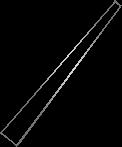
SECTION 2.2 Changes in Lengths of Axially Loaded Members 119
(c) SAME DIAMETER, SAME LOAD, FIND RATIO OF LENGTH OF ALUMINUM TO STEEL WIRE IF ELONGATION OF ALUMINUM IS 1.5 TIMES THAT OF STEEL WIRE
Problem 2.2-4 By what distance h does the cage shown in the figure move downward when the weight W is placed inside it?
Consider only the effects of the stretching of the cable, which has axial rigidity EA 10,700 kN. The pulley at A has diameter dA 300 mm and the pulley at B has diameter dB 150 mm. Also, the distance L1 4.6 m, the distance L2 10.5 m, and the weight W 22 kN. (Note: When calculating the length of the cable, include the parts of the cable that go around the pulleys at A and B.)
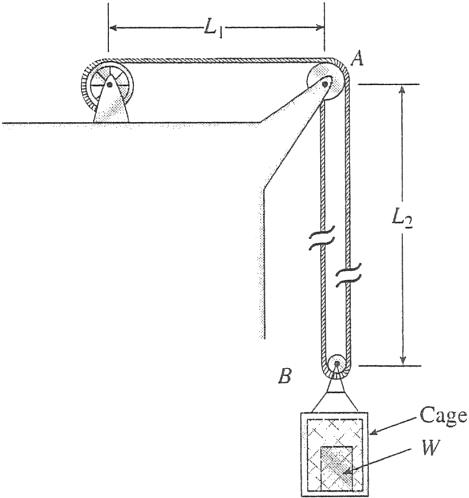
120 CHAPTER 2 Axially Loaded Members
Solution 2.2-4 Cage supported by a cable
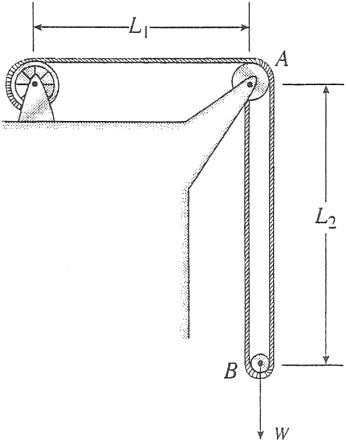
dA 300 mm
dB 150 mm
L1 4.6 m
L2 10.5 m
EA 10,700 kN
W 22 kN
LENGTH OF CABLE 1 1
L L1 + 2L2 + 4 1pdA2 + 2 (pdB) 4,600 mm + 21,000 mm + 236 mm + 236 mm 26,072 mm
ELONGATION OF CABLE
TL (11 kN)(26,072 mm)
d EA (10,700 kN) 26.8 mm
LOWERING OF THE CAGE
h distance the cage moves downward
TENSILE FORCE IN CABLE
W T 11 kN 2
1
h d 13.4 mm ; 2
Problem 2.2-5 A safety valve on the top of a tank containing steam under pressure p has a discharge hole of diameter d (see figure). The valve is designed to release the steam when the pressure reaches the value pmax
If the natural length of the spring is L and its stiffness is k, what should be the dimension h of the valve? (Express your result as a formula for h.)

SECTION 2.2 Changes in Lengths of Axially Loaded Members 121
Solution 2.2-5 Safety valve
pmax pressure when valve opens
L natural length of spring (L h)
k stiffness of spring
FORCE IN COMPRESSED SPRING
F k(L h) (From Eq. 2-1a)
PRESSURE FORCE ON SPRING
pd2
P pmaxa 4 b
EQUATE FORCES AND SOLVE FOR h: ppmaxd2
h height of valve (compressed length of the spring)
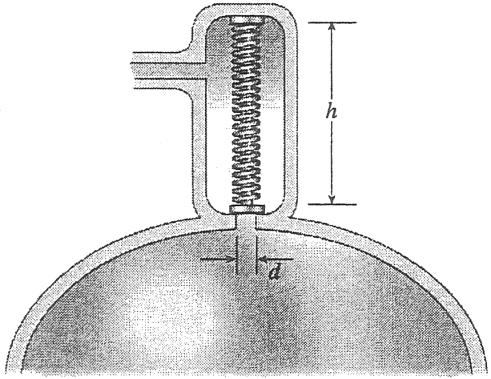
d diameter of discharge hole
p pressure in tank
F P k1L h2 4
ppmax d2 h L ; 4 k
Problem 2.2-6 The device shown in the figure consists of a prismatic rigid pointer ABC supported by a uniform translational spring of stiffness k 950 N/m. The spring is positioned at distance b 165 mm from the pinned end A of the pointer. The device is adjusted so that when there is no load P, the pointer reads zero on the angular scale.
(a) If the load P 11 N, at what distance x should the load be placed so that the pointer will read u 2.5° on the scale (see figure part a)?
(b) Repeat part (a) if a rotational spring kr kb2 is added at A (see figure part b).
(c) Let x 7b/8. What is Pmax (N) if u cannot exceed 2°? Include spring kr in your analysis.
(d) Now, if the weight of the pointer ABC is known to be Wp 3 N and the weight of the spring is Ws 2.75 N, what initial angular position (i.e., u in degrees) of the pointer will result in a zero reading on the angular scale once the pointer is released from rest? Assume P kr 0.
(e) If the pointer is rotated to a vertical position (see figure part c), find the required load P, applied at mid-height of the pointer, that will result in a pointer reading of u 2.5° on the scale. Consider the weight of the pointer Wp in your analysis.
122 CHAPTER 2 Axially Loaded Members
2.2-6
(a) If the load P 11 N, at what distance x should the load be
placed so that the pointer will read u
on the scale
(b) Repeat (a) if a rotational spring kr kb2 is added at A (see
Fig. b).
(c) Now if x 7b/8, what is Pmax (N) if
(d) Now, if the weight of the pointer ABC is known to be Wp 3 N and the weight of the spring is Ws 2.75 N, what initial angular position (i.e., u in degrees) of the pointer will result in a zero reading on the angular scale once the pointer is released from rest? Assume P kr 0.
to self weight of spring:
SECTION 2.2 Changes in Lengths of Axially Loaded Members 123
(e) If the pointer is rotated to a vertical position (figure part c), find the required load P, applied at mid-height of the pointer that will result in a pointer reading of u 2.5° on the scale. Consider the weight of the pointer, Wp, in your analysis.
Problem 2.2-7 Two rigid bars are connected to each other by two linearly elastic springs. Before loads are applied, the lengths of the springs are such that the bars are parallel and the springs are without stress.
(a) Derive a formula for the displacement d4 at point 4 when the load P is applied at joint 3 and moment PL is applied at joint 1, as shown in the figure part a. (Assume that the bars rotate through very small angles under the action of the load P)
(b) Repeat part (a) if a rotational spring, kr kL2 , is now added at joint 6. What is the ratio of the deflection d4 in the figure part a to that in the figure part b?
124 CHAPTER 2 Axially Loaded Members
Solution 2.2-7
(a) Derive a formula for the displacement d4 at point 4 when the load P is applied at joint 3 and moment PL is applied at joint 1, as shown.
Cuthorizontallythroughbothsprings to create upperandlower FBD’s. Summoments aboutjoint1forupperFBD and also sum moments about joint 6 for lower FBD to get two equations of equilibrium; assume both springs are in tension. Note
Summing moments about joint 1 (upper FBD) and about joint 6 (lower FBD) then dividing through by k gives
^ deltas are positive downward
(b) Repeat part (a) if a rotational spring kr kL2 is now added at joint 6. What is the ratio of the deflection d4 in part (a) to that in (b)?
^ deltas are positive downward
in part (a) to that in (b):
SECTION 2.2 Changes in Lengths of Axially Loaded Members 125
Problem 2.2-8 The three-bar truss ABC shown in figure part a has a span L 3 m and is constructed of steel pipes having cross-sectional area A 3900 mm 2 and modulus of elasticity E 200 GPa. Identical loads P act both vertically and horizontally at joint C, as shown.
(a) If P 475 kN, what is the horizontal displacement of joint B?
(b) What is the maximum permissible load value Pmax if the displacement of joint B is limited to 1.5 mm?
(c) Repeat parts (a) and (b) if the plane truss is replaced by a space truss (see figure part b).
Solution 2.2-8
NUMERICAL DATA
A 3900 mm 2 E 200 GPa P 475 kN L 3000 mm
dBmax 1.5 mm
(a) FIND HORIZONTAL DISPLACEMENT OF JOINT B
STATICS TO FIND SUPPORT REACTIONS AND THEN MEMBER FORCES:
gMA 0 By 1 L L a2 P 2 b
By P
gFH 0 Ax P
gFV 0 Ay P By Ay 0
ACV AY ACV 0 Force in AC 0
(a) METHOD OF JOINTS: AB AX
Force in AB is P (tension) so elongation of AB is the horizontal displacement of joint B dB FAB L dB EA PL dB 1.82692 mm dB

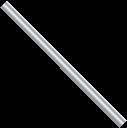
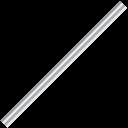
(b) FIND Pmax IF DISPLACEMENT OF JOINT B dBmax 1.5 mm
(c) REPEAT PARTS (a) AND (b) IF THE PLANE TRUSS IS REPLACED BY A SPACE TRUSS (SEE FIGURE PART b).
FIND MISSING DIMENSIONS a AND c: P 475 kN L 3 m
CHAPTER 2 Axially Loaded Members
SUM MOMENTS ABOUT A LINE THRU A WHICH IS PARALLEL TO THE y-AXIS
ABOUT THE z-AXIS
(6) FIND DISPLACEMENT ALONG x-AXIS AT JOINT B Find change in length of member AB then find its projection along x axis:
(7) FIND Pmax FOR SPACE TRUSS IF Bx MUST BE LIMITED TO 1.5 mm
Displacements are linearly related to the loads for this linear elastic small displacement problem, so reduce load variable
SECTION 2.2 Changes in Lengths of Axially Loaded Members 127
Reactions obtained using vector operations agree with those based on scalar operations.
Problem 2.2-9 An aluminum wire having a diameter d 1/10 in. P
and length L 12 ft is subjected to a tensile load P (see figure). The aluminum has modulus of elasticity E 10,600 ksi
If the maximum permissible elongation of the wire is 1/8 in. and the allowable stress in tension is 10 ksi, what is the allowable load Pmax?
128 CHAPTER 2 Axially Loaded Members
Problem 2.2-10 A uniform bar AB of weight W 25 N is supported by two springs, as shown in the figure. The spring on the left has stiffness

k1 300 N/m and natural length L1 250 mm The corresponding quantities for the spring on the right are k2 400 N/m and L2 200 mm The k1 b distance between the springs is L 350 mm, and the spring on the right is suspended from a support that is distance h 80 mm below the point
of support for the spring on the left Neglect the weight of the springs.
should a load P 18 N be placed in order to bring the bar to a
horizontal position?
(b) If P is now removed, what new value of k1 is required so that the weight W?
(c) If P is removed and k1 300 N/m, what distance b should spring k1 be moved to the right so that the bar (figure part a) will hang in a horizontal position under weight W?
(d) If the spring on the left is now replaced bytwo springs in series k3 (k1 300N/m, k3) with overall natural length L1 250 mm (see L figure part b), what value of k3 is required so that the bar will hang in a horizontal position under weight W?
only
SECTION 2.2 Changes in Lengths of Axially Loaded Members 129
Solution 2.2-10
NUMERICAL DATA
W 25 N k1 0.300 N/mm L1 250 mm
k2 0.400 N/mm L2 200 mm
L 350 mm h 80 mm P 18 N
(a) LOCATION OF LOAD P TO BRING BAR TO HORIZONTAL POSITION
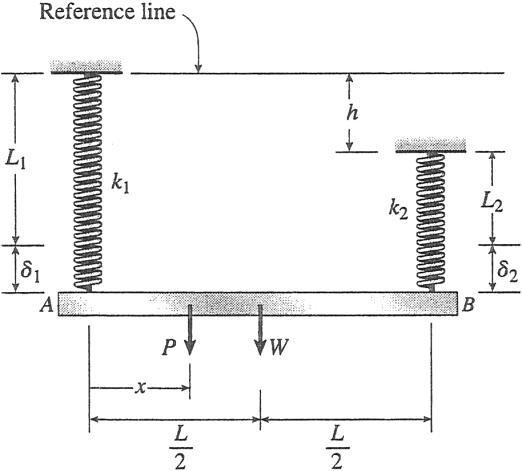
Use statics to get forces in both springs: 1 L
a MA 0 F2 L aW 2 + Pxb W x F2 2 + P L
a FV 0 F1 W + P F2
W x F1 2 + Pa1 L b
Use constraint equation to define horizontal position, then solve for location x:
L1 + F1 k1 L2 + h + F2 k2
Substitute expressions for F1 and F2 above into constraint equilibrium and solve for x:
130 CHAPTER 2 Axially Loaded Members
(b) NEXT REMOVE P AND FIND NEW VALUE OF SPRING CONSTANT k1 SO THAT BAR IS HORIZONTAL UNDER WEIGHT W
constraint equation as above but now P
[
(
+ h)]] W
(c) USE k1 0.300 N/mm BUT RELOCATE SPRING k1 (x b) SO THAT BAR ENDS UP
Constraint equation substitute above expressions for F1 and F2 and solve for b: IN HORIZONTAL POSITION UNDER WEIGHT W
(d) REPLACE SPRING k1 WITH SPRINGS IN SERIES:
74.1 mm ; New constraint equation; solve for k3:
/2, AND
IN HORIZONTAL POSITION
/2. FIND k3 SO
NOTE equivalent spring constant for series springs:
SECTION 2.2 Changes in Lengths of Axially Loaded Members
Problem 2.2-11 A hollow, circular, cast-iron pipe (Ec 12,000 ksi) supports a brass rod (Eb 14,000 ksi) and weight W 2 kips, as shown The outside diameter of the pipe is dc 6 in.
(a) If the allowable compressive stress in the pipe is 5000 psi and the allowable shortening of the pipe is 0.02 in., what is the minimum required wall thickness tc,min? (Include the weights of the rod and steel cap in your calculations.)
(b) What is the elongation of the brass rod dr due to both load
W and its own weight?
(c) What is the minimum required clearance h?
Solution 2.2-11
The figure shows a section cut through the pipe, cap, and rod.
(a) MINIMUM REQUIRED WALL THICKNESS OF CAST IRON PIPE, tcmin
First check allowable stress then allowable shortening:
132 CHAPTER 2 Axially Loaded Members
(b) ELONGATION OF ROD DUE TO SELF WEIGHT AND ALSO WEIGHT
Now
Problem 2.2-12 The horizontal rigid beam ABCD is supported by vertical bars BE and CF and is loaded by vertical forces
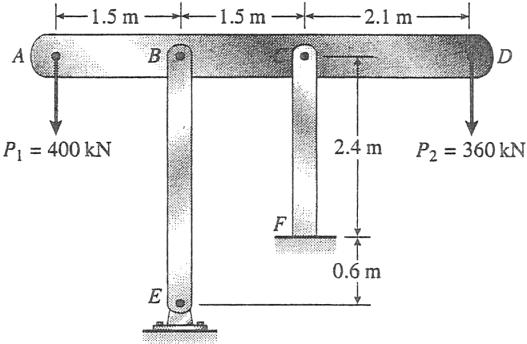
P1 400 kN and P2 360 kN acting at points A and D, respectively (see figure). Bars BE and CF are made of steel (E 200 GPa) and have cross-sectional areas ABE 11,100 mm2 and ACF 9,280 mm2 . The distances between various points on the bars are shown in the figure.
Determine the vertical displacements dA and dD of points A and D, respectively
SECTION 2.2 Changes in Lengths of Axially Loaded Members 133
Solution 2.2-12 Rigidbeam supported by vertical bars
SHORTENING OF BAR BE dBE FBELBE EABE
(296 kN)(3.0 m) (200 GPa)(11,100 mm2)
0.400 mm
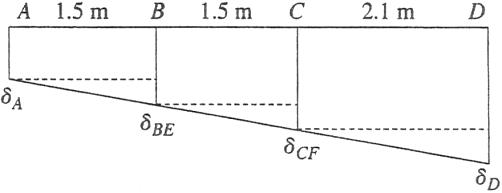
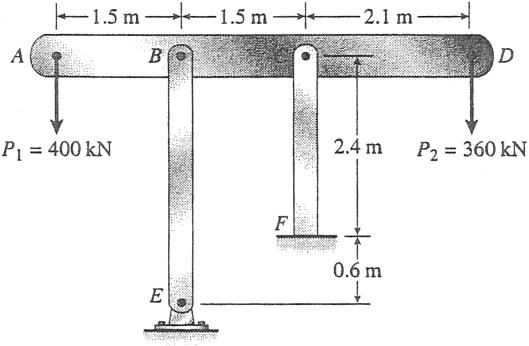
SHORTENING OF BAR CF dCF FCFLCF EACF
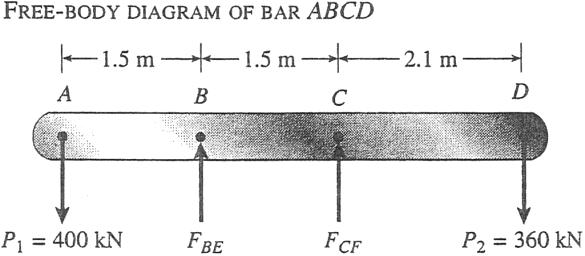
(464 kN)(2.4 m) (200 GPa)(9,280 mm2)
ABE 11,100 mm 2
ACF 9,280 mm2
E 200 GPa
LBE 3.0 m
LCF 2.4 m
P1 400 kN; P2 360 kN
134 CHAPTER 2 Axially Loaded Members
Problem 2.2-13 Two pipe columns (AB, FC) are pin-connected to a rigid beam (BCD) as shown in the figure. Each pipe column has modulus E, but heights (L1 or L2) and outer diameters (d1 or d2) are different for each column. Assume the inner diameter of each column is 3⁄4 of outer diameter Uniformly distributed downward load q 2P/L is applied over a distance of 3L/4 along BC, and concentrated load P/4 is applied downward at D
(a) Derive a formula for the displacement dD at point D in terms of P and column flexibilities
BCD displaces downward to a horizontal posi-
tion under the load system in (a)
(c) If L1 2 L2, find the d1/d2 ratio so that beam BCD displaces downward to a horizontal position under the load system in (a)
(d) If d1 (9/8) d2 and L1/L2 1.5, at what horizontal distance x from B should load P/4 be placed so that beam BCD displaces downward to a horizontal position under the load system in part (a)?
SECTION 2.2 Changes in Lengths of Axially Loaded Members 135
136 CHAPTER 2 Axially Loaded Members
Problem 2.2-14 A framework ABC consists of two rigid bars AB and B BC, each having a length b (see the first part of the figure part a). The b b bars have pin connections at A,B, and C and are joined by a spring of
stiffness k. The spring is attached at the midpoints of the bars. The framework has a pin support at A and a roller support a C, and the bars b b are at an angle a to the horizontal.
When a vertical load P is applied at joint B (see the second part of
the figure part a) the roller support C moves to the right, the spring is stretched, and the angle of the bars decreases from a to the angle u
(a) Determine the angle u and the increase d in the distance between points A and C Also find reactions at A and C (Use the following data: b 200 mm, k 3.2 kN/m, a 45 , and P 50 N.)
(b) Repeat part (a) if a translational spring k1 k/2 is added at C and a rotational spring kr kb2/2 is added at A (see figure part b).
(a) Initial position of structure
(a) - cont’d: displaced position of structure
Solution 2.2-14
(b) Displaced structure
Apply the laws of statics to the structure in its displaced position; also use FBD’s of the left and right bars alone (referred to as LHFB and RHFB below).
SECTION 2.2 Changes in Lengths of Axially Loaded Members 137
138 CHAPTER 2 Axially Loaded Members
Problem 2.2-15 Solve the preceding problem for the following data: b 8.0 in., k 16 1b/in., a 45 , and P 10 1b Solution 2.2-15
Apply the laws of statics to the structure in its displaced position; also use FBD’s of the left and right bars alone (referred to as LHFB and RHFB below)
Equate the two expressions above for RC then substitute expressions for
and
Changes in Lengths under Nonuniform Conditions
Problem 2.3-1
(a) Calculate the elongation of a copper bar of solid circular cross section with tapered ends when it is stretched by axial loads of magnitude 3.0 k (see figure).
(The length of the end segments is 20 in. and the length of the prismatic middle segment is 50 in. Also, the diameters at cross sections A, B, C, and D are 0.5, 1.0, 1.0, and 0.5 in., respectively, and the modulus of
elasticity is 18,000 ksi. (Hint: Use the result of Example 2-4.)
(b) If the total elongation of the bar cannot exceed 0.025 in., what are the required diameters at B and C? Assume that diameters at A and D remain at 0.5 in.
140 CHAPTER 2 Axially Loaded Members
Problem 2.3-2 A long, rectangular copper bar under a tensile load P hangs from a pin that is supported by two steel posts (see figure). The copper bar has a length of 2.0 m, a cross-sectional area of 4800 mm2 , and a modulus of elasticity Ec 120 GPa. Each steel post has a height of 0.5 m, a cross-sectional area of 4500 mm2 , and a modulus of elasticity Es 200 GPa.
(a) Determine the downward displacement d of the lower end of the copper bar due to a load P 180 kN.


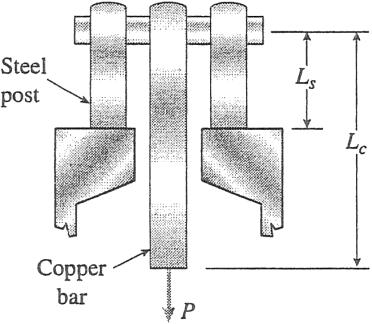
(b) What is the maximum permissible load Pmax if the displacement d is limited to 1.0 mm?
Solution 2.3-2 Copperbar with a tensile load
(a) DOWNWARD DISPLACEMENT d (P 180 kN)
PLc dc E A (180 kN)(2.0 m)
c c (120 GPa)(4800 mm2)
0.625 mm
(P/2)Ls (90 kN)(0.5 m)



ds
E As s (200 GPa)(4500 mm2)
mm
d dc + ds 0.625 mm + 0.050 mm
mm ;
(b) MAXIMUM LOAD Pmax (dmax 1.0 mm)
Problem 2.3-3 An aluminum bar AD (see figure) has a cross-
sectional area of 0.40 in.2 and is loaded by forces P1 1700 lb, P2 1200 lb, and P3 1300 lb. The lengths of the segments of the bar are a 60 in., b 24 in., and c 36 in.
(a) Assuming that the modulus of elasticity E 10.4 106 psi, calculate the change in length of the bar Does the bar elongate or shorten?
(b) By what amount P should the load P3 be increased so that the bar does not change in length when the three loads are applied?
(c) If P3 remains at 1300 lb, what revised cross-sectional area for segment AB will result in no change of length when all three loads are applied?
142 CHAPTER 2 Axially Loaded Members
Problem 2.3-4 A rectangular bar of length L has a slot in the middle half of its length (see figure). The bar has width b, P thickness t, and modulus of elasticity E The slot has width b/4.
(a) Obtain a formula for the elongation d of the bar due to the axial loads P.
(b) Calculate the elongation of the bar if the material is high-strength steel, the axial stress in the middle region is 160 MPa, the length is 750 mm, and the modulus of elasticity is 210 GPa.
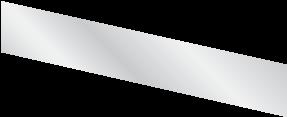
(c) If the total elongation of the bar is limited to
max 0.475mm, what is the maximum length of the slotted region? Assume that the axial stress in the middle region remains at 160 MPa.
Problem 2.3-5 Solve the preceding problem if the axial stress in the middle region is 24,000 psi, the length is 30 in., and the
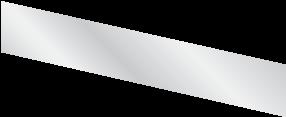
modulus of elasticity is 30 * 106 psi. In part (c), assume that
Problem 2.3-6 A two-story building has steel columns AB in the first floor and BC in the second floor, as shown in the figure The roof load P1 equals 400 kN and the second-floor load P2 equals 720 kN. Each column has length L 3.75 m The cross-sectional areas of the first- and second-floor columns are 11,000 mm 2 and 3,900 mm 2 , respectively
(a) Assuming that E 206 GPa, determine the total shortening dAC of the two columns due to the combined action of the loads P1 and P2
(b) How much additional load P0 can be placed at the top of the column (point C) if the total shortening dAC is not to exceed 4.0 mm?
144 CHAPTER 2 Axially Loaded Members
Solution 2.3-6 Steel columns in a building
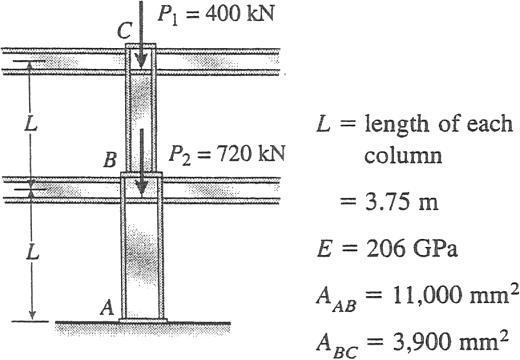
(b) ADDITIONAL LOAD P0 AT POINT C
(dAC)max 4.0 mm
d0 additional shortening of the two columns due to the load P0
d0 (dAC)max dAC 4.0 mm 3.7206 mm 0.2794 mm P0L P0L P0L 1 1 Also, d0 AB
A EA EA + b
+ BC E a AAB BC
Solve for P0:
(a) SHORTENING dAC OF THE TWO COLUMNS Ed0 AAB ABC NiLi dAC g E A NABL EA NBCL + EA P0 L a AAB + ABC b
i i AB BC
(1120 kN)(3.75 m)
(206 GPa)(11,000 mm2)
(400 kN)(3.75 m) + (206 GPa)(3,900 mm2)
SUBSTITUTE NUMERICAL VALUES:
E 206 109 N/m2 d0 0.2794 10 3 m
L 3.75 m AAB 11,000 10 6 m 2
ABC 3,900 10 6 m 2
P0 44,200 N 44.2 kN ; 1.8535 mm + 1.8671 mm 3.7206 mm
dAC 3.72 mm ;
Problem 2.3-7 A steel bar 8.0 ft long has a circular cross section of diameter d1 0.75 in. over one-half of its length and diameter d2 0.5 in. over the other half (see figure part a). The modulus of elasticity E 30 * 106 psi.
(a) How much will the bar elongate under a tensile load P 5000 lb?
(b) If the same volume of material is made into a bar of constant diameter d and length 8.0 ft, what will be the elongation under the same load P?
(c) If the uniform axial centroidal load q 1250 lb/ft is applied to the left over segment 1 (see figure part b), find the ratio of the total elongation of the bar to that in parts (a) and (b).
d1 = 0.75 in.
d2 = 0.50 in. q = 1250 lb/ft
P
4.0 ft 4.0 ft
d1 = 0.75 in.
P = 5000 lb d2 = 0.50 in.
(a) 4.0 ft 4.0 ft
(b)
P = 5000 lb
Problem 2.3-8 A bar ABC of length L consists of two parts of equal lengths but different diameters. Segment AB has diameter d1 100 mm, and segment BC has diameter d2 60 mm. Both segments have length L/2 0.6 m.
A longitudinal hole of diameter d is drilled through segment AB for one-half of its length (distance L/4 0.3 m). The bar is made of plastic having modulus of elasticity E 4.0 GPa.



Compressive loads P 110 kN act at the ends of the bar
(a) If the shortening of the bar is limited to 8.0 mm, what is the maximum allowable diameter dmax of the hole?
(See figure part a.)
(b) Now, if dmax is instead set at d2/2, at what distance b from end C should load P be applied to limit the bar shortening to 8.0 mm? (See figure part b)
(c) Finally, if loads P are applied at the ends and P dmax d2/2, what is the permissible length x of the hole if shortening is to be limited to 8.0 mm? (See figure part c.)
146 CHAPTER 2 Axially Loaded Members
2.3-8
(a) FIND dmax IF SHORTENING IS LIMITED TO da
(b) NOW, IF dmax IS INSTEAD SET AT d2 2, AT WHAT DISTANCE
C SHOULD LOAD P BE APPLIED TO LIMIT THE
Problem 2.3-9 A wood pile, driven into the earth, supports a
load P entirely by friction along its sides (see figure part a). The friction force f per unit length of pile is assumed to be uniformly distributed over the surface of the pile The pile has length L, cross-sectional area A, and modulus of elasticity E of P, L, E, and A.
(b) Draw a diagram showing how the compressive stress sc
(c) Repeat parts (a) and (b) if skin friction f varies linearly with depth (see figure part b).
148 CHAPTER 2 Axially Loaded Members
Problem 2.3-10 Consider the copper tubes joined below using a “sweated” joint. Use the properties and dimensions given.
(a) Find the total elongation of segment 2-3-4 (d2-4) for an applied tensile force of P 5 kN. Use Ec 120 GPa.
(b) If the yield strength in shear of the tin-lead solder is ty 30 MPa and the tensile yield strength of the copper is sy 200 MPa, what is the maximum load Pmax that can be applied to the joint if the desired factor of safety in shear is FSt 2 and in tension is FSs 1.7?
(c) Find the value of L2 at which tube and solder capacities are equal.
Tin-lead solder in space between copper tubes; assume thickness of solder equal zero
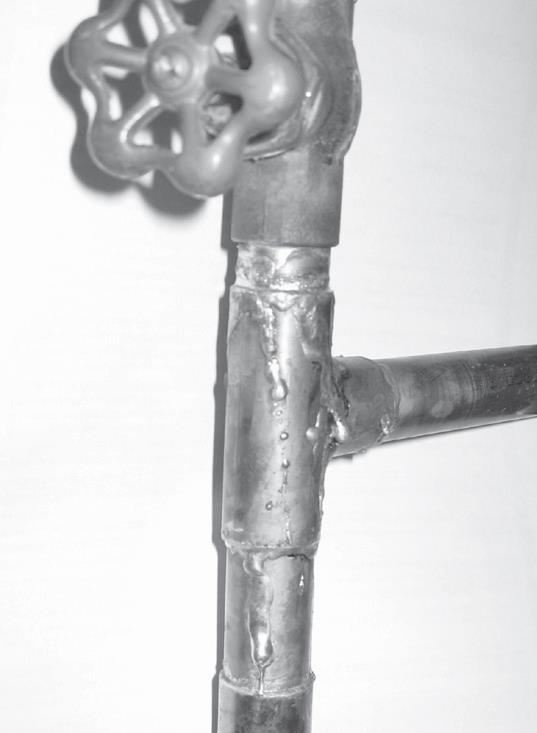
SECTION 2.3 Changes in Lengths under Nonuniform Conditions 149
(b) MAXIMUM LOAD Pmax THAT CAN BE APPLIED TO THE
Problem 2.3-11 The nonprismatic cantilever circular bar shown has an internal cylindrical hole of diameter d/2 from 0 to x, so the net area of the cross section for Segment 1 is (3/4)A. Load R P is applied at x, and load P/2 is applied at x L Assume that E is constant.
(a) Find reaction force R1
(b) Find internal axial forces Ni in segments 1 and 2.
(c) Find x required to obtain axial displacement at joint 3 of d3 PL/EA
(d) In (c), what is the displacement at joint 2, d2?
(e) If P acts at x 2L/3 and P/2 at joint 3 is replaced by bP, find b so that d3 PL/EA
(f) Draw the axial force (AFD: N(x), 0 x L) and axial displacement (ADD: d(x), 0 x L) diagrams using results from (b) through (d) above.
CAPACITIES ARE EQUAL Set Pmax based on shear strength equal to Pmax based on tensile strength and solve for L2:
150 CHAPTER 2 Axially Loaded Members
Solution 2.3-11
(b) DRAW FBD’S CUTTING THROUGH SEGMENT 1 AND AGAIN THROUGH SEGMENT 2
(c) FIND x REQUIRED TO OBTAIN AXIAL DISPLACEMENT AT JOINT 3 OF d3 PL/EA Add axial deformations of segments 1 and 2, then set
x ;
(d) WHAT IS THE DISPLACEMENT AT JOINT 2, d2?
(f) Draw AFD, ADD see plots for x 3
Problem 2.3-12 A prismatic bar AB of length L, cross-sectional area A, modulus of elasticity E, and weight W hangs vertically under its own weight (see figure).
(a) Derive a formula for the downward displacement C of point C, located at distance h from the lower end of the bar
(b) What is the elongation B of the entire bar?
(c) What is the ratio b of the elongation of the upper half of the bar to the elongation of the lower half of the bar? h
(d) If bar AB is a riser pipe hanging from a drill rig at sea, what is the total elongation of the pipe? Let L 1500 m, A 0.0157 m2 , E 210 GPa. See Appendix I for weight densities of steel and sea B water (See Problems 1.4-2 and 1.7-11 for additional figures).
SECTION 2.3 Changes in Lengths under
Solution 2.3-12 Prismatic bar hanging vertically
151
152 CHAPTER 2 Axially Loaded Members
Problem 2.3-13 A flat bar of rectangular cross section, length L, and constant thickness t is subjected to tension by b2 forces P (see figure). The width of the bar varies linearly

from b1 at the smaller end to b2 at the larger end. Assume that the angle of taper is small.
(a) Derive the following formula for the elongation of b1 the bar:
(b) Calculate the elongation, assuming L 5 ft, t 1.0 in., P 25 k, b1 4.0 in., b2 6.0 in., and E 30 106 psi.
Solution 2.3-13 Tapered bar (rectangular crosssection)
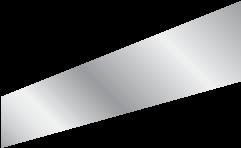
ELONGATION
BAR Substitute Eqs. (3) and (4) into Eq. (2):
Problem 2.3-14 A post AB supporting equipment in a laboratory
is tapered uniformly throughout its height H (see figure). The cross sections of the post are square, with dimensions b b at the top and 1.5b 1.5b at the base.










































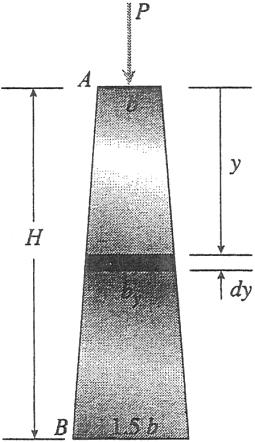
Derive a formula for the shortening d of the post due to the compressive load P acting at the top (Assume that the angle of taper is small and disregard the weight of the post itself.)
Solution 2.3-14 Tapered post
154 CHAPTER 2 Axially Loaded Members
Problem 2.3-15 A long, slender bar in the shape of a right circular cone d with length L and base diameter d hangs vertically under the action of its own weight (see figure). The weight of the cone is W and the modulus of elasticity of the material is E
Derive a formula for the increase d in the length of the bar due to its own weight. (Assume that the angle of taper of the cone is small.)
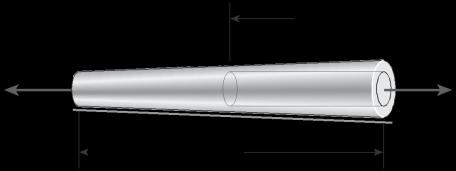
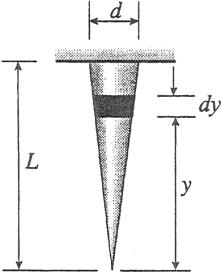
Solution 2.3-15 Conical bar hanging vertically
dy
Problem 2.3-16 A uniformly tapered plastic tube AB of circular cross section and length L is shown in the figure The average diameters at the ends are dA and dB 2dA Assume E is constant Find the elongation d of the tube when it is subjected to loads P acting at the ends Use the following numerial data: dA 35 mm, L 300 mm, E 2.1 GPa, P 25 kN Consider two cases as follows:
(a) A hole of constant diameter dA is drilled from B toward A to

form a hollow section of length x L/2 (see figure part a)
(a)
SECTION 2.3 Changes in Lengths under
(b) A hole of variable diameter d(x) is drilled from
B toward A to form a hollow section of length x L/2
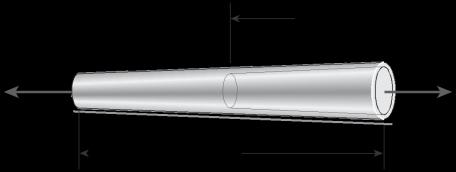
and constant thickness t (see figure part b) (Assume P
that t dA/20.)
